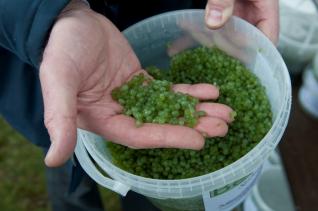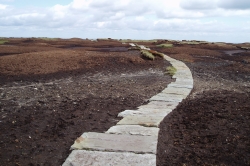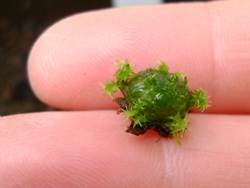A groundbreaking new approach to moorland conservation starts this week as we begin airlifting 150 million ‘beads’ of Sphagnum moss to help bring life back to the Peak District and South Pennine moors.
In the first operation of its kind, Sphagnum gel beads known as BeadaMoss™ will be airlifted by helicopter in five-litre tubs, starting on Black Hill in the Peak District National Park.

MoorLIFE, one of the largest conservation projects in the UK, is re-introducing this key peat-forming moss in a huge landscape-scale operation covering 2400 acres (980 hectares) across the hills of Northern England.
This pioneering work, developed through the Sphagnum Propagation Project and funded by the Co-operative Foundation and Natural England, started with an original small source of local Sphagnum which was grown-on and multiplied in the laboratory and finally placed in special gel beads.
Each tiny bead, the size of a small fingernail, contains several small strands of moss. The gel helps to weigh down the moss and aid application on the moors as well as provide a vital food source and protection from the harsh climate. The aim is for the moss to grow out of the bead and begin to colonise the moors and bring the moors back to a healthy and sustainable condition once more. This production technique requires only a small amount of local source Sphagnum.
The Sphagnum beads will be spread by hand onto re-vegetated areas by staff, volunteers, Peak District National Park rangers and a local contractor to act as a key element in the formation of new peat. Peat is the biggest single store of carbon in the UK, helping climate change adaptation.
Matt Buckler, conservation works manager for the Moors for the Future Partnership said: “All our works to date have been about stabilising the ground until peat-forming vegetation can develop. Sphagnum is the building block that created and sustains our peatland moorlands and so this project is probably the most important landscape-scale delivery phase of works ever in UK moorland restoration.”


Photos: Black Hill in 2004 (left) and 2011 (right)
Jim Dixon, chief executive of the Peak District National Park Authority, confirmed the importance of re-introducing Sphagnum: “This pioneering work and its vast scale is an amazing achievement and milestone in the project and the partnership’s history. Its importance is far reaching - not only will it benefit communities and wildlife in the National Park but also across the South Pennines and Europe.
“I would like to extend my thanks to all staff and partners involved for their continued hard work, commitment and belief in this pioneering approach to return our valuable moorlands back to a healthy and sustainable condition .”
Lord Smith, chairman of the Environment Agency, who has visited Black Hill to see past conservation works by the team and is a key partner of the MoorLIFE project, endorsed this vital work: “The re-introduction of Sphagnum moss - in this truly innovative project - will add still further to the remarkable success of the Moors for the Future programme. Restoring the peat cover for the Peak District moorlands has huge conservation, environmental and climate change benefits.”
